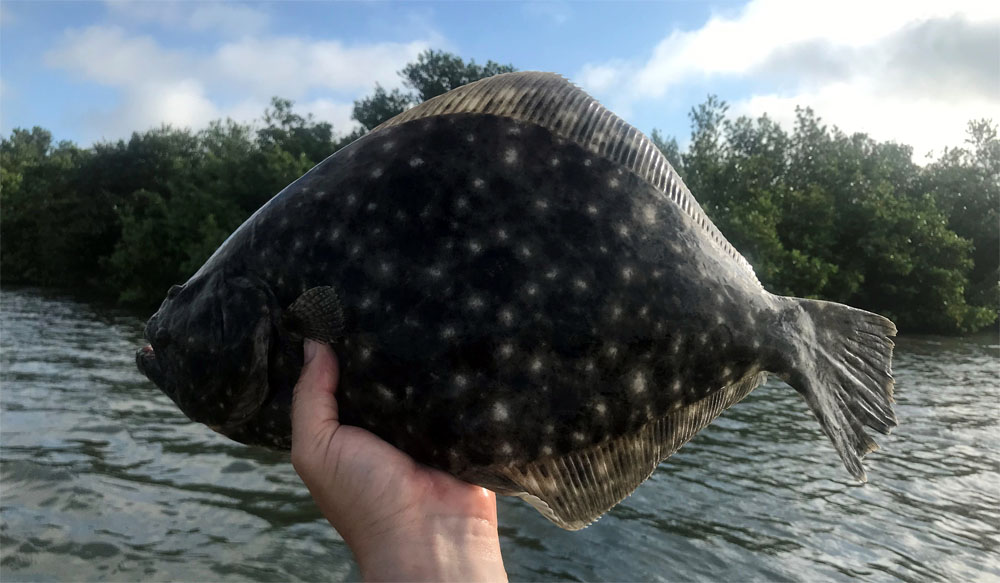

Their eyes are on the same side of their body after being fully grown. Flounder Fun Facts What do Flounders look like?įlounders are dark on the front and lighter towards the bottom. Since people are not aware and are mercilessly fishing these species for their own benefit, their conservation status is of Least Concern. The look of these fish depends upon their area of birth and surrounding, even their coloration varies. On the completion of this process, these fish are considered full-grown flounders. It has an eye on each side of its head unlike a flounder the shifting of one eye starts as it grows. The larva then swims in the water, and it looks like a normal fish. Larvae hatch from the fertilized eggs a couple of weeks later. The formed eggs float on the surface because of the presence of an oil bubble, which protects it too. Female flounders release eggs, and at the same time male flounders release sperm in the water.

The mating process starts during the hottest season of the year. Other reasons for their death can be if they fall prey to other animals such as sharks, even fishing by human beings causes death to a lot of these flounders. These animals consume the waste that is thrown into water bodies and often die because of it. Water pollution is another important reason that leads to the death of a lot of species that live in water. Especially due to global warming, the lives of these aquatic animals are threatened. These fish live for three - 10 years on average. It depends on their population at that particular place, and the type of flounder too. These flatfish live solitary lives, whereas some live in similar habitats. The Mariana Trench is the deepest part of the Pacific Ocean. Did you know? In 1960, a scientist found these fish in the Mariana Trench. A lot of these fishes can be found deepest trench of the ocean. Each species has its preference in terms of habitat, some like to stay in between water while others like to rest and wait for smaller aquatic species to approach. They live on the waterside of tropical and temperate coastal waters, near docks, bridges, or reefs. Flounder fish are mostly found in coastal areas. There are about 30 million flounders in the world. How many Flounders are there in the world? What class of animal does a Flounder belong to?Ī Flounder belongs to the class of fish. If you are curious to know about other animals, check out Codfish and Herring.įlounder Interesting Facts What type of animal is a Flounder?Ī flounder is a fish. Keep reading to know more about summer flounder facts, southern flounder facts, and more. The species of Bothidae and Paralichthyidae have their eye on the left, whereas the Pleuronectidae family has its on the right. They can be differentiated on the basis of color and the location of their eyes.

The eyes are always looking for prey from the nearby waters.

The bottom part of their body is light in color, while the upper part along with the eyes is bright. A flounder's origin may be European, Atlantic, and more. They swim sideways and are mostly found in saltwater. They can live up to three - eight years in the wild. They can be distinguished easily because of their eyes and their flat body.įlounders are nocturnal animals, that is they are mostly active during the night. These species of flatfish can change the color of their body in just two to eight seconds. Flounders are lurking predators, and use their quality to blend in with the surface to catch their food. These are small fish that are mostly found in the oceans, coastal water, near the docks, bridges, and reefs. Their flat bodies help them blend with the surrounding. Just as the name suggests, these fish are thin, round, and lie flat on the surface of the water. 30578).Flounder Fish belong to the same group as halibut, which are an unusual species of flatfish. Worms and mollusks are excellent baits for line fishing (Ref. Marketed fresh and frozen can be steamed, fried, boiled, microwaved and baked (Ref. 51442), including small fishes and invertebrates (Ref. Juveniles of less than a year old feed on plankton and larvae of insects, juveniles of more than a year and adults feed on benthic fauna (Ref. 57574), which are also the summer feeding grounds for the adults (Ref. Juveniles live in shallow coastal waters and estuaries (Ref. 57575) using a range of triggers such as salinity, prey density and water temperature (Ref. Larvae and early juveniles use selective tidal transport to migrate upstream rivers (Ref. The growing larvae are moving to the coast (Ref. During winter, adults retreat to deeper, warmer waters, where they spawn in spring (Ref. Adults occur on mud and sand bottom in shallow water, at sea and brackish often entering freshwaters (Ref. Migratory fish, which is most of the year found in estuaries (Ref.


 0 kommentar(er)
0 kommentar(er)
